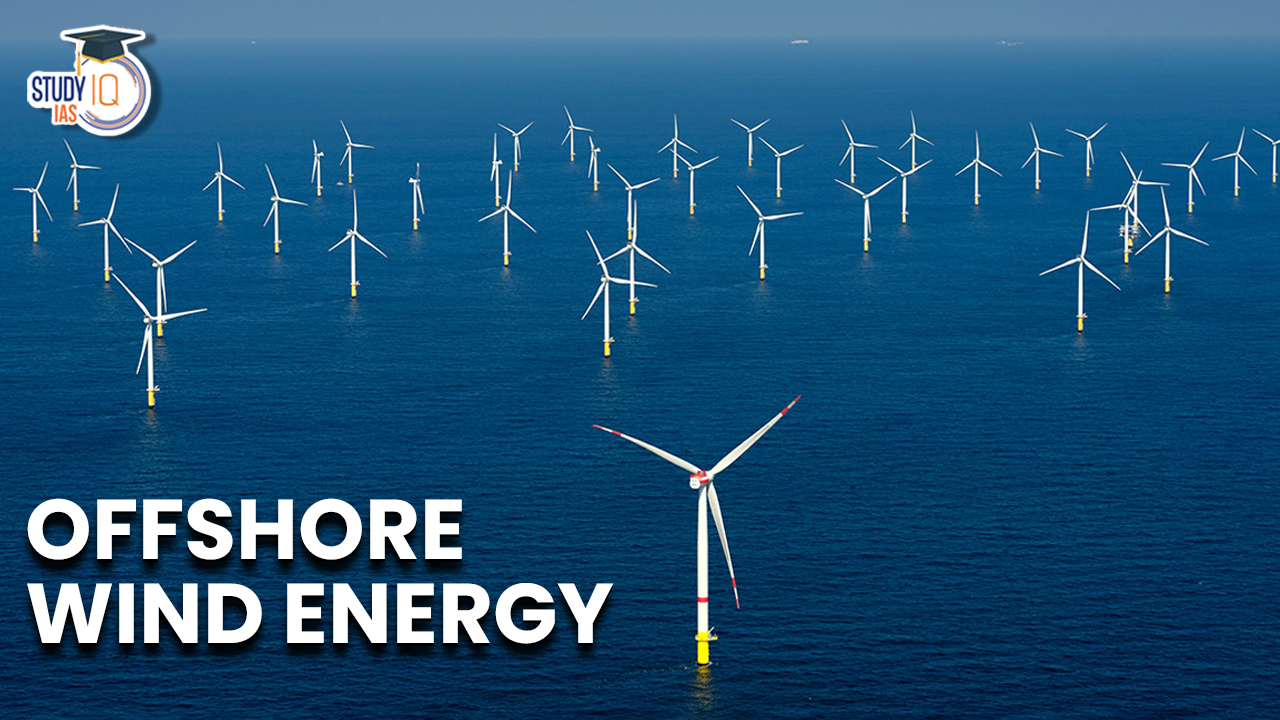Table of Contents
Context: The Union Ministry of New and Renewable Energy (MNRE) has issued a tender for the construction of India’s first set of offshore wind projects off the coast of Tamil Nadu.
What is Offshore Wind Energy?
- Wind energy is the process of using the wind to generate electricity. It is one of the fastest-growing renewable energy technologies.
- There are two ways in which energy can be harnessed:
- Onshore wind energy: It is the power that’s generated by wind turbines located on land driven by the natural movement of the air.
- Offshore wind energy: It is the energy generated from wind farms that are located over shallow open water, usually in the ocean, where there are higher wind speeds.
- Offshore wind farms must be at least 200 nautical miles from the shore and 50 feet deep in the ocean.
India’s Offshore Wind Energy Potential
- According to the MNRE, India can generate 127 GW of offshore wind energy with its 7,600 km of coastline.
- Out of the total estimated potential, more than 95% of commercially exploitable resources are located in seven states: Andhra Pradesh, Gujarat, Karnataka, Madhya Pradesh, Maharashtra, Rajasthan and Tamil Nadu
- Also, the National Institute of Wind Energy (NIWE) estimated 36 GW of offshore wind energy potential exists off the coast of Gujarat and 35 GW off the Tamil Nadu coast only.
Advantages of Offshore Wind Energy
- High Efficiency: Offshore wind turbines are more efficient than onshore ones because they benefit from high and consistent wind speeds over water.
- Reliability: It is a reliable source of baseload power, i.e., it can generate electricity 24/7. It is due to the stronger and more consistent sea winds.
- Scalability: Offshore wind energy is a scalable technology, meaning that it can be developed on a large scale to meet the growing energy needs.
- Land Availability: Offshore wind farms address the issue of limited land availability in densely populated areas like India by utilizing water bodies for energy production.
- Environmental Benefits: Offshore wind farms do not require water for operation and produce no greenhouse gas emissions during energy generation.
Challenges with Offshore Wind Energy
- Higher cost: Creating the infrastructure for offshore wind farms is expensive and complex, especially over deeper waters.
- Maintenance & repairs: Sea waves and very high winds can damage turbines, so they need more maintenance. Also, Offshore wind farms are difficult to access, which means longer wait times for repairs.
- Impact marine life: The underwater noises from turbines can impact fauna and other marine life.
Steps taken by the Government to promote Offshore Wind Energy
- National Offshore Wind Energy Policy, 2015: The policy provides for offshore wind power development up to a seaward distance of 200 nautical miles from the baseline, i.e., up to the country’s EEZ.
- Ministry of New & Renewable Energy (MNRE) is the Nodal Ministry, and the National Institute of Wind Energy (NIWE) is the Nodal Agency for the development of Offshore Wind Energy in India.
- Government had also announced installing of 5 GW of offshore wind installations by 2022 and 30 GW by 2030.
- Ministry of New & Renewable Energy (MNRE) released Strategy Paper for Establishment of Offshore Wind Energy Projects.
- The paper identifies 16 zones in total, off the coasts of Gujarat and Tamil Nadu for harnessing offshore wind energy.
- It proposes three models for the holistic development of offshore wind farms in the country.
| Model A |
|
| Model B |
|
| Model C |
|
Way Forward
- Facilitating Offshore Wind in India (FOWIND) project classifies five “action items” that are critical to implementation of offshore wind in India, which include:
- Development of a long-term offshore roadmap.
- Clear consenting and permitting procedures.
- Regional and national grid development.
- Financial support mechanisms.
- Development of skills and competences.


 Daily Quiz 03 July 2025
Daily Quiz 03 July 2025
 Dalai Lama Confirms He will have a Succe...
Dalai Lama Confirms He will have a Succe...
 List of Awards and Honours Received by N...
List of Awards and Honours Received by N...





















